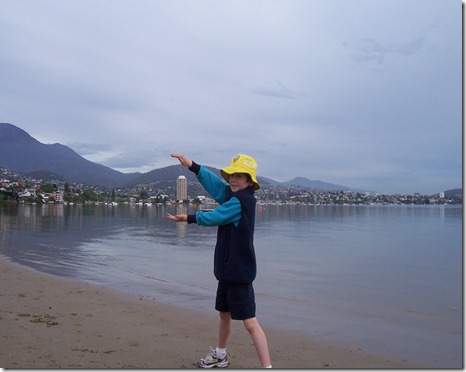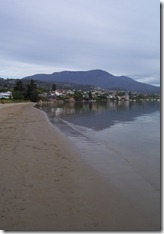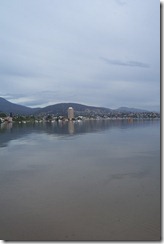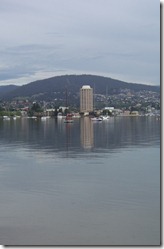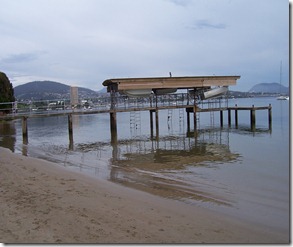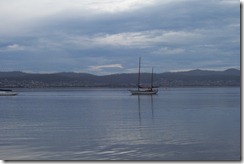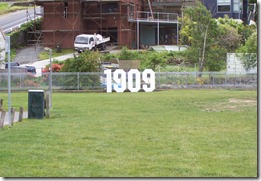Ive passed my first University subject. Web 101
Thanks to all that have helped me along the way and thanks to my tutors and lecturers
Welcome, Im so glad you could join me on my journey to discover photographically the beauty of my surroundings, the many moods of my majestic mountain, Mount Wellington and life that thrives in the foot hills that she governs.
Thursday, December 2, 2010
Friday, November 19, 2010
IN REFLECTION
Life throws us unexpected things, as I look toward the end of my 1st study period..I reflect…in photographic style as I have done so for the past 13 weeks. I've included photos of Mt Wellington and the Derwent River that rolls and rumbles through the centre of Hobart Tasmania, and ponder at their reflective qualities on the still and shimmering water.
all photos taken by Laura with a 5 megapixel Kodak camera. Creative Commons Attribution 3.0 Unported License. http://creativecommons.org
Thursday, November 18, 2010
In conclusion WEB 101 Topic 3.3 Laura's notes
Web 101: Communication and Collaboration Online
Laura’s notes
Topic 3.3 – Future Trends
Introduction:
By now, you will have a good background on the evolution of communication and participation over the Internet. Yet, as you have seen, changes occur very quickly in this realm - the idea of Web 2.0 was only really articulated in 2004. This week, as you conclude your studies and finalise your web presence assignment, we will look at some possibilities for the future of the web and how they might impact (influence) the way we use, communicate through and perceive it. (Curtin, 2010)
Instructions:
Follow through the information on this page, stopping to view any videos and performing the activities and readings as you get to them.Web 3.0 – The Semantic Web
Laura: I watched an interesting YouTube video titled “Intro to the Semantic Web”. An interesting vision of what the Semantic Web “could” become and an explanation that I thought quite interesting. YouTube embedded video Url: http://www.youtube.com/watch?v=OGg8A2zfWKg&feature=player_embedded
I also came across another video about Web 1.0, Web 2.0 and the progression to Web 3.0 on YouTube url: Evolution Web 1.0, Web 2.0 to Web 3.0 http://www.youtube.com/watch?v=bsNcjya56v8&feature=related that I thought was also interesting an related to what we have been reviewing.
Reading - The Semantic Web
Berners-Lee, T., Hendler, J. & Lassila, O. (2001), 'The Semantic Web' Scientific American Magazine, May 2001, Vol. 284 Issue 5, p34.
Extract from reading:
THE SEMANTIC WEB
A new form of Web content that is meaningful to computers will unleash a revolution of new
Possibilities
The entertainment system was belting out the Beatles' "We Can Work It Out" when the phone rang. When Pete answered, his phone turned the sound down by sending a message to all the other local devices that had a volume control. His sister, Lucy, was on the line from the doctor's office: "Mom needs to see a specialist and then has to have a series of physical therapy sessions. Biweekly or something. I'm going to have my agent set up the appointments." Pete immediately agreed to share the chauffeuring. At the doctor's office, Lucy instructed her Semantic Web agent through her handheld Web browser. The agent promptly retrieved information about Mom's prescribed treatment from the doctor's agent, looked up several lists of providers, and checked for the ones in-plan for Mom's insurance within a 20-mile radius of her home and with a rating of excellent or very good on trusted rating services. It then began trying to find a match between available appointment times (supplied by the agents of individual providers through their Web sites) and Pete's and Lucy's busy schedules. (The emphasized keywords indicate terms whose semantics, or meaning, were defined for the agent through the Semantic Web.) ...
The Mobile Web
The principal shift that mobile devices are bringing to the Web experience is that of localised content through location-aware GPS functions. With the added context of location, web-based applications are able to offer an augmentation of the real world by providing information that shifts as we do. More importantly perhaps, the collaborative culture of Web 2.0 and beyond can be further enhanced by this kind of location awareness. We have already seen the beginnings of this in geo-tagging, but the area is still relatively under-explored.
While the most obvious application of the mobile web is that embedded in devices that we carry with us, wireless technologies can theoretically be utilised to connect any electronic device to the Internet. The promise of smart appliances has been with us for quite a while (Who doesn't dream of owning an Internet-enabled Fridge?!), but with the growing availability of wireless access, we can expect to see growing inter-connectivity between (and access to) appliances. (Curtin, Tama Lever, 2010)
Laura: I thought this was an interesting angle and explanation concerning the mobility of the internet today. Although I cannot see carrying a fridge in my pocket as something of a revolutionary aspect, maybe a back breaking one...(joke) I find this future footstep interesting and I look forward to some sort of interactive bracelet that gives a holographic projection of the semantic web i.e. point and use!
In conclusion to this week AND the unit I watched all the videos:
Kevin Kelly, Web and Where: Web 3.0 (... the web that we have at the moment is less than 5000 days old ...T.V but better ...) http://www.youtube.com/watch?v=J132shgIiuY&feature=player_embedded
Google Wave Overview: While Google's Wave was hailed as the next great thing in late 2009, it has taken a considerable time to become popular. http://www.youtube.com/watch?v=p6pgxLaDdQw&feature=player_embedded
Laura: I joined Googlewave, https://wave.google.com/wave/ it’s an interesting concept but you do need to have more than one person using it. I delegate this type of functionary tool as one that is best used as a communal one. For those that are using Internet Explorer it is necessary to download the Chrome Shell but be aware it might interfere with your web face and cause the browser to crash intermittently. It’s a tool best utilised with either Firefox or Safari (and yes, you do not have to be using an Apple/Mac computer to be able to use Safari as the browser integrates quite well across all platforms. I have found that both Fire fox and Safari are actually better and have greater stability than Internet Explorer. Keep in mind this is MY person view and opinion)
Activity: Food for thought.....
Tuesday, November 16, 2010
Internet Studies (Net 102) Assignment 4 Essay 2
Internet Studies 102 (Net 102) Assignment 4: Essay 2
Curtin University Grade: 75%
Laura Herbert
Essay Question: Critically evaluate this statement: the Internet offers a space where people may resist oppression on a daily basis; it overturns traditional structures of power and control.
Technological Freedom
There are technological advances of the Internet compared to the printed book page that have the ability to democratize information by simplifying the creation, skill, knowledge, duplication, storage and fluidity of distribution of data. By utilising applications, networking through computers can facilitate communication amongst a broader spectrum of individuals. People from remote locations are able to associate with one other by creating user accounts specifically to engage in varieties of social networking, fighting the suppression of human rights, the invocation of freedom and political practices, and more generally to make their utopian visions of opinions matter by having their voices heard on a unified global platform. This essay will argue technology's usage to enhance people's options for greater communication in an online environment and to discuss the capacity of online community's ability to overturn the traditional structures of power and control allowing people to resist oppression by utilising the Internet's ubiquitous ability for freedom of social expression.Literacy has been an important developmental mile stone in human history, it represented a time that saw the emergence of abstract thought and linear forms of thinking and expression as well as a change of perception of space and time. (Harris, 2003. Hongladarom, 2002) When Gutenberg invented the printing press in the 15th century information began to distribute to a greater number of people in more diverse places at a cheaper cost than that of hand written Latin language manuscripts deleteriously produced by monks. Although machine printed books of that era kept in large libraries were accessible to the masses, only the elite, powerful, educated and religious educators could afford to access the books, keeping power and control of information distribution in the hands of the minority and not the majority.(Solove, 2007)
Don Slater in his paper Social Relationships and Identity Online and Offline makes an interesting observation concerning peoples adaptation of information "…past media have also seemed to constitute new forms and spaces of sociality, even virtuality's, they have quickly been absorbed into every day practices as utilities …" (cited McLuhan 1974,Standage 1999 by Slater, 2002). Although before the ubiquitous application of the internet in the later part of the 20th Century, choices of mass media consumption were limited in the form of the printed newspaper, radio and television. These facilities greatly accelerated the dissemination of information albeit in a mostly singular direction lending significant power to the hands of a small but significant group of editors and producers of printing, recording and broadcasting technology. Communication by individuals meeting and talking and the use of the telephone contained groups to a specific social environment until the widened public use of the Internet. The commonality of use of the Internet changed the dynamic nature of information sharing and with this technological change came technological structure and a widening degree of personal and political freedom.danah boyd's article Facebook's Privacy Trainwreck, Exposure, Invasion, and Social Convergence, directs the reader to the idea that people require structure in the real world but not on line. "… Off line, people are accustomed to having architecturally defined boundaries ..." The idea of actual life defined boundaries does not physically apply to the context of the Internet. For religious, political and even suppressed ideals, the Internet has allowed for greater range of freedom and in doing so offers individuals and masses a widened information sharing capability with access to platforms such as social networking sites, political, religious and human rights web pages. These technological structures easily altered to fit a user's specific demographic and individual requirement of spatial usability. boyd concurs in her article "… The digital world has different properties and these can be easily altered through the development of new technologies …" (2008)
The development of new technologies has widened people's ability for greater communication with each other, creating a divergence of concepts and culture. Shafti describes understanding information distribution as communal in Incoherent Thoughts "… As the reality of the information age becomes more certain, people are beginning to understand the vast expanse of new media …" As such users are interacting with each other socially and culturally in a greater capacity. People are connecting in interesting and new ways and for some the internet ingrained in such a way that communication and accessibility electronically are part of a daily routine that allows them freedom from constraints of the traditional structures of power and control. Community and identity as Shafti points out can be "… different people from different parts of the world establish a virtual community in cyber space. Here they share their ideas, opinions, belief, political perspectives, interests etc. …" (2005) This utopian vision and the opening of internet frontiers has enabled people to connect with others that they would not have otherwise have met in a real life setting. People create communities with common ground for different reasons, overriding a degree of possible oppressive social or political behaviour and giving the users greater acceptance within a specific on line peer structure.
Early theorists speculated that electronic communication would be inherently democratic, allowing equal access to data and knowledge, modern communication and transportation technologies have made the classical notion of world politics obsolete. The Internet has evolved from a communication conduit between scientists and engineers engaged in defence work to an information dissemination tool used to resist human rights abuses worldwide, it is the natural vocation of a conscious people to resist oppression. Territorial boundaries, however much bolstered by doctrines of sovereignty are no-longer impregnable; the Internet has made them porous. Increasingly easy access to e-mail and the World Wide Web allows many politically disenfranchised groups to communicate with like-minded or sympathetic audiences, publicising causes often overlooked by the mainstream media and offering perspectives frequently stifled by the conservative corporate ownership.There are a multitude of platforms that any number of disembodied users can and do utilise. "... social network sites (SNS) such as MySpace Facebook, Cyworld, and Bebo..." researched and described by boyd and Ellison (2007) concur with Shafti's previously discussed perspective of community and identity, "…there are hundreds of SNSs, with various technological affordances, supporting a wide range of interests and practices. While their key technological features are fairly consistent, the cultures that emerge around SNSs are varied. Most sites support the maintenance of pre-existing social networks, but others help strangers connect based on shared interests, political views, or activities. Some sites cater to diverse audiences, while others attract people based on common language or shared racial, sexual, religious, or nationality-based identities …" (boyd, Ellison, 2002)
Social network site Facebook has demonstrated the ability to create common ground for various causes whether they are fighting the suppression of human rights, the invocation of freedom and political practices, and more generally utopian or dystopian visions (Shafti, 2005) of private individuals. Within a couple of minutes, a person is able to generate and establish a particular 'interest wall' that displays a link to their cause's main web site which a member may visit if they wish. With this ease of access Facebook's utilities has been employed by a growing number of human rights groups. Consumers of the social networking site are able to demonstrate their allegiance by mouse clicking a 'like' button at the top of the wall page. "...Facebook, Human Rights Watch Non-profit 70,226 people like this. Facebook, Human Rights Campaign Non-profit 646,643 people like this. Facebook, Australian Human Rights Commission Government 3,096 people like this. Facebook, Human rights Page 30,100 people like this. Facebook, Universal Declaration of Human Rights Non-profit 25,191 people like this. Facebook, The Cambodian Center for Human Rights (CCHR) Non-profit 2,713 people like this ..." (Facebook, November 15, 2010) No longer are people "...happily oblivious to this social network website ..." (White, 2008)
By demonstrating people's connection to each other on a social networking site (SNS) such as Facebook this paper has shown that strangers are able to connect on the Internet in a common cause and in doing so have created an online community of like minded individuals. In comparing technological advances before and after the Internet's inception, this essay has argued technology's usage to enhance people's options for greater communication in an online environment are able to usurp the traditional structures of power and control allowing people to resist oppression by utilising the Internet's ubiquitous ability to form communities that represent and allow freedom of social expression.
Bibliography
boyd, d. (2008) Facebook's Privacy Trainwreck. Exposure, Invasion, and Social Convergence. Convergence: The International Journal of Research into New Media Technologies. (pp.14) Retrieved November 14, 2010 Curtin University of Technology
http://jcmc.indiana.edu/vol13/issue1/boyd.ellison.html
http://www.danah.org/papers/FacebookPrivacyTrainwreck.pdf
boyd, d. m. , & Ellison, N. B (2007) Social Network sites; Definition, History and Scholarship. Journal of Computer Mediated Communication 13(1) article 11 Retrieved November 14, 2010 from
Eisenstein, E. (1982) The Printing Press as an Agent of Change. European History after 1450. Cambridge University Press. (pp. 1-20 Inc. preface). Reviewed November 14th 2010.
Facebook Human rights heading Search,
http://www.facebook.com/search.php?q=human+rights&init=quick&tas=0.07180594468679424 Retrieved from Facebook November 15, 2010
Facebook, Human Rights Watch http://www.facebook.com/HumanRightsWatch?v=wall / http://www.hrw.org/ Retrieved from Facebook. November 15, 2010.
Harris, Laurel. (2003) Time, space. In Theories of Media (University of Chicago) Archived by Webcite. Retrieved November 14, 2010 Curtin University of Technology
http://docs.law.gwu.edu/facweb/dsolove/Future-of-Reputation/text/futureofreputation-ch2.pdfhttp://csmt.uchicago.edu/glossary2004/timespace.htm
Hongladarom, Soraj. 2002. "The Web of Time and the Dilemma of Globalization," The Information Society 18(4), (pp. 241 – 249, pp. 242). Retrieved November 14, 2010 from, Curtin University of Technology Library E-Reserve
Shafi, "Can a Virtual Community be any different from the experience of a Real Community?" Incoherent Thoughts, December 13, 2005. Archived by Web cite. Curtin University of Technology Retrieved November 14, 2010
http://shafisaid.wordpress.com/2005/12/13/can-a-virtual-community-be-any-different-from-the-experience-of-a-real-community/
Slater, Don. (2002). Social Relationships and Identity Online and Offline. In Leah A. Lievrouw & Sonia M. Livingstone (Eds.), Handbook of New Media (pp. 533-546). Cited in paper: McLuhan, M (1974) Standage, T (1999) Retrieved November 14, 2010 from, Curtin University of Technology Library E-Reserve.
Solove, D., (2007). How the Free Flow of Information Liberates and Constrains Us, in The Future of Reputation: Gossip, Rumor and Privacy on the Internet. (pp. 18) Retrieved November 14, 2010
The National Archives, Human Rights Archive
http://www.nationalarchives.gov.uk/humanrights/ Reviewed November 15, 2010.
Please do not plagiarise my work. I am quite happy however for you to quote or cite my assignment. This assignment submitted to Curtin University of Technology for grading.
White, M M., “Facebook Suicide ,"Adbusters, June 4, 2008. Archived by WebCite Curtin University of Technology. Retrieved November 15, 2010
Monday, November 15, 2010
Net 102 Assignment 2 Essay 1 Sex blogs and Social Acceptance
Internet Studies 102/502: The Internet and Everyday Life
Assignment: 2
Essay: 1
Grade: Distinction (73%)
Sex Blogs and Social Acceptance
Adult materials such as pornography, sexual blogging and dating have become part of everyday life, particularly for regular anonymous internet users. Pornography and varying degrees of sexual content are now considered part of mainstream websites through forms of blogs, advertising and various connective links. Blogs, with particular attention to hentai (app1) presumably contain content that has a large percentage of pornographic images and sexual content associated with them. This paper will discuss how internet users regularly utilise blog sites that contain varying degrees of pornographic (app 2) / altporn (app 3) content and as such blogs of a sexual nature are showing greater acceptability within main stream internet use with lesser degrees on anonymity.
Wellman and Haythornthwaite write, “It is time for more differentiated analyses of the Internet to take into account how it has increasingly become embedded in everyday life. The master issue is whether the Internet is drawing us away from everyday life or adding layers of connectivity ...” (Wellman and Haythornthwaite, 2002). The evolution of the internet and its content has generated extended study and discussion forums concerning involvement and integration into everyday lives. As a form of new media technology, the internet is now regarded as being one of the most pivotal and accessible technologies available.
While there are certain regulations in place for the entry into some pornographic websites, pornography is thriving on the internet, discovered either intentionally or accidentally by most Internet users. Society as a whole is extremely interested in the subject of sex both in real life and via the World Wide Web.
Schnarch and Morehouse. Social Psychologists, report that “... sex is one of the most researched items on the internet today ...” (2002). Fiske shows us that “... distance is a key marker of difference between high and low culture, between the meanings, practices and pleasures characteristic ...” (2008). Sexual viewing or supplying of either explicit photographic images, adult and or child, authoring or reading web diaries or web streaming facilities such as pay per view or membership orientated sites that incorporate hentai or non mainstream sexual practices could possibility contribute to social misunderstanding if the user is exposed.
The Internet may serve as an important platform for sexual self-expression and as such the explicit sexual content of blog websites that has been viewed or contributed to may be an instigating factor for hiding identity on line and off, “...freedom of expression and the right to privacy, use of anonymity is legal...” (Palme, Berglund 2002)
The Collins English Dictionary defines Weblogs as:
· Personal Web site that provides updated headlines and news articles of other sites that are of interest to the user; also may include journal entries, commentaries and recommendations compiled by the user; also written web log; also called blog.
Rebecca Blood comments on the origins of blogs, “... original weblogs were link-driven sites. Each was a mixture in unique proportions of links, commentary, and personal thoughts and essays ...” (Blood, 2000). Attwood suggests in her article ‘No Money shot ...’(2007) that “... rich technology ensures web sites create ease of access that has enabled and even increased the involvement of users and the participatory nature of a cross section of society ...”
Technorati, one of the largest blog directories on the World Wide Web is currently tracking 1242412 (Technorati, 2010) blogs of various subjects. It is unknown how many sexually orientated blogs exist in the blogosphere.
Blogs of a hentai nature written by women have tended to attract large followings. Blogs titled such as Girl with a one track mind, Wonkette/Washingtonienne, Belle De Jour, Tasty Trixie and Eros have gained altporn pop culture status over the last decade. And as such “... porn is able to become chic ...” (Attwood, 2007). In 2004 the graphic sexual blog written under the pseudonym of Abby Lee, Girl with a One Track Mind by Zoe Margolis began its inception and rise in popularity with a simple objective, as stated by Zoe Margolis “... I decided to write about sex in my blog because I felt that the feminist and female-centred perspective is missing from mainstream media ...” (2008). Since 2004, the blog has become extremely popular showing a readership per annum in the millions, earning the site twenty fourth ranking by the British website, The Guardian in their 50 most powerful blogs. The inclusion of ‘Girl with a One Track Mind’ on the afore mentioned list suggests that blogs of a sexual nature are showing greater acceptability within main stream internet use and as such integration and reading of blogs of similar class content are becoming a social normality instead of a social abnormality.
Sexual blog sites of varying genre have garnered wider social acceptance within the internet community per say and as such a lessening degree of anonymity has been demonstrated. This paper has explained how internet users are utilising blog sites that contain varying degrees of sexual content and as such sexuality of the World Wide Web has become part of everyday life in internet mediated activities.
Bibliography
Attwood, F. (2007). No Money Shot? Commerce, Pornography and New Sex Taste Cultures. Sexualities, 10(4), 441-456. Retrieved 6/10/2010 from Curtin University of Technology Library E-Reserve
Barak, A. (ed.) (2008). Psychological aspects of cyberspace: theory, research, applications Ch. 8. The Sexy Side of the Internet: an Examination of Sexual Activities and materials in Cyberspace. p 185-208 (p 189) Retrieved 9/10/2010 from Curtin University of Technology Library E-Reserve
Blood, R."Weblogs: A History and Perspective", Rebecca's Pocket. 07 September 2000. 26 July 2010. http://www.rebeccablood.net/essays/weblog_history.html Retrieved 7/10/2010
Cutin University (2010) Web 101, Net 102 Course information, Retrieved 5/10/2010
Cutin University (2010) iLecture: Web 101 Blogs by Dr Tama Lever, Retrieved 6/10/2010
Ess. C, Sudweeks. F , Voiskounsky A (1998) Proceedings Cultural Attitudes Towards Communications and Technology. Internet: Culture Diversity and Unification, Retrieved 8/10/2010
http://www.it.murdoch.edu.au/~sudweeks/catac98/pdf/07_voiskounsky.pdf
Fiske, J. (1992). Cultural Studies and the Culture of Everyday Life. In Lawrence Grossberg, Cary Nelson, & Paula A Treichler (Eds.), Cultural Studies (pp. 154-173). New York: Routledge
Guardian News and Media Ltd (2010) world’s 50 most powerful blogs.
http://www.guardian.co.uk/technology/2008/mar/09/blogs Retrieved 9/10/2010
Hine, C. (2000) Virtual Ethnography. Sage Publications Ltd. Retrieved 8/10/2010 p 37-44
Margolis, Z (2008) Zoe Margolis. Retrieved 9/10/2010
http://www.zoemargolis.co.uk
Meyer, C. (1993-1994) Sex, Sin, and Women's Liberation: Against Porn-Suppression. Tex. L. Rev. 1097 http://heinonline.org/HOL/LandingPage?collection=journals&handle=hein.journals/tlr72&div=39&id=&page Retrieved 9/10/2010
Palme,J and Berglund, M. (2007) Anonymity on the internet.
http://people.dsv.su.se/~jpalme/society/anonymity.html Retrieved 9/10/2010
Schnarch,D, Ph.D. and Morehouse,S, Ph.D. (2002) Online Sex, Dyadic Crises, and Pitfalls for MFTs Sept/Oct., issue of Family Therapy Magazine Retrieved 8/10/2010
weblog. (n.d.). Collins English Dictionary - Complete & Unabridged 10th Edition. Retrieved October 06, 2010 , from Dictionary.com website: http://dictionary.reference.com/browse/weblog
Wellman, B and Haythornthwaite, C (2002): The Internet in Everyday Life
Blackwell Publishers, Oxford, An introduction (p 8) (alk.paper) Retrieved6/10/2010 from Curtin University of Technology Library E-Reserve
Blackwell Publishers, Oxford, An introduction (p 8) (alk.paper) Retrieved
Appendix
1. Hentai: Sexually explicit media images.
2. Pornography: It is notoriously difficult to define pornography, definitions rest on the prejudgement and prejudices of the viewer. Ambiguous terms: writings, drawings, photographs or like. (Meyer, 1994)
3. Altporn: Sometimes called punk porn or indie porn, as these names suggest, has a particular subculture focus. (Attwood, 2008)
Facebook Suicide. Interesting article
Disclaimer: I have not written this article, I make no claim to have written this article.
Micah M. White, "Facebook Suicide ," Adbusters, June 4, 2008. Archived by WebCite.
This piece for an activist magazine issues a call for to leave Facebook; read the comments as well. What relationships between the control of our social networking information (power), community, identity, profit (economy) and privacy does this highlight?
Commit Facebook Suicide, Adbusters #77
Like most Americans in their mid-twenties, I am a child of the computer-age. That I did not immediately jump on the Facebook wagon is not due to an innate dislike of technology or an irrational fear of the web, but merely because I graduated from college before Facebook became a university fad. I was, like an ever-decreasing number of people, happily oblivious to this social network website. But then something troubling happened: my wedding photos appeared on Facebook.
In a typical website, a user may upload a photograph, write a funny caption and that's it. But in Facebook, users are asked to identify who else is in the photo. This is the crucial difference that allowed a friend of a friend of a friend to view pictures of my wedding a bridesmaid had uploaded. Although neither my wife nor I ever joined Facebook, our names, pictures, social connections and wedding photographs were already in its database. With 60 million users busily adding information about their hobbies, political positions, employment, education, friends and plans for the weekend, you too might be in Facebook without your knowledge.
My first reactions to learning about my presence on Facebook were contradictory. On the one hand, I felt the thrill of social connectedness - an exhibitionist feeling of delight at having my existence confirmed by a third-party. But I also felt violated and confused. Having never used Facebook, I couldn't understand how my wedding pictures had gotten there or who was now able to view them. And I became concerned about what Facebook will do with the information it's collecting about me.
In a recent Fast Company magazine article, Facebook's vice-president of product marketing and operations explained that while companies like Google are concerned with "demand fulfillment" - helping a consumer find the product they want - Facebook is cornering the market in "demand generation" - subtly encouraging individuals to consume products and services they'd otherwise not care for.
The first step toward demand generation was encouraging users to share information about their interests, favorite movies and books, and political beliefs that would allow Facebook to send advertisements targeted to their demographic. The second, controversial step that Facebook took is to partner with dozens of online retailers so that when a Facebook member buys a widget on a partner's site, all their Facebook "friends" find out. The sinister system they have developed would be akin to my computer automatically emailing my address book when I purchase a book online.
By turning members into consumers who involuntarily advertise to their friends, Facebook hoped to extract profit from social interactions. However, by commercializing friendships, Facebook has irrevocably destroyed its image. And now, a vanguard of the anti-Facebook movement is developing out of the increasing number of members who have seen the commercial direction that the site is going and the effect it's having on their social relationships. No longer a fun, harmless place to hang out, Facebook has become just another commercial enterprise.
Because Facebook has intentionally made it very difficult for users to leave the site, demanding that they manually delete every bit of information that they added into the system before their account will be removed, a growing number of users are fleeing the site by committing what has been called "Facebook Suicide." By manually removing their Facebook friends before deleting their account, indignant users ensure that their friends are fully aware of the real reasons why they are leaving the site.
The movement could reach epidemic levels as more members commit Facebook Suicide. If users prefer to kill off their electronic selves rather than submit to corporate control of their friendships, then Facebook, and the other corporate lackeys, will learn that they can't exploit our social relationships for profit. From viral growth will come a viral death as more demand that Facebook must die so that our friendships may thrive.
UPDATE: Caving to pressure, Facebook has made it easier to get off the network. Click here to commit Facebook suicide today.
Wednesday, November 10, 2010
wHEN eRROL fLYNN rULED tHE wORLD..
Tuesday, November 9, 2010
Web 101 Topic 3.2 Social Me(dia) Laura’s notes
Web 101
Topic 3.2 Social Me(dia)
Laura's notes
Intro:
While the web was famously described as Small Pieces Loosely Joined (a unified theory of the web, David Weinberger: "What is the Web for? And why do we care so much? Why has this simple technology sent a lightning bolt through our culture? It goes far beyond the Web's over-hyped economic impact: 500 million of us aren't there because we want a better "shopping experience." The Web, a world of pure connection, free of the arbitrary constraints of matter, distance and time, is showing us who we are - and is undoing some of our deepest misunderstandings about what it means to be human in the real world".) At the begging of the millennium, since 2006, the joins are often harder to see and the pieces are getting smaller and smaller. Our output of Facebook status updates, Twitter posts (called tweets), Last.FM playlist updates, and the different posts from a thousand other services all leave tiny fragments of information about ourselves, our like, our dislikes, our habits and so on. The topic we'll be considering how those fragments are used, what they say about people, and how combined in different ways.(Curtin, 2010)
David Weinberger: Flap Copy (april 2002)
The Web doesn't exist in space, yet we talk about going to sites, entering themand leaving. Diaries move on line and suddenly they're more about creating selves than writing about Tthem. Web sites don't have fences, yet a site for auction hunters was found to have trespassed on eBay, a metaphorical offense for which it paid a very real price. Companies invest heavily in professional, polished Web sites, but the Web rewards sites that revel in imperfection. Bits are the "atoms" of the Web, but they have no weight, no size and no real existence.
These anomalies are just a few that show how uncomfortable the fit between the Web and the real world is - and how deeply weird the ordinary life of the Web is. In this one-of-a-kind book of social commentary, David Weinberger takes us beyond the hype, revealing what is truly revolutionary about this new medium. Just as Marshall McLuhan forever altered our view of broadcast media, Weinberger shows that the Web is transforming not only transforming social institutions but also bedrock concepts of our world such as space, time, self, knowledge - even reality itself.
The Web would be important enough if it hooked up our species on a global scale. But, Weinberger argues, it is doing much more than that. Unlike previous technologies, such as the phone or fax, the Web is a permanent public space that gathers value every time someone posts a Web page, or responds on a discussion board, or replies to a mail list. The result is that the Web is a second world, layered on top of the real world, that's drawing into it more and more of our social life lives together.
Weinberger introduces us to the denizens of this second world, people like .Zannah, whose online diary turns self-revelation into play; Tim Bray, whose map of the Web reveals what's at the heart of the new Web space; and Danny Yee and Claudiu Popa, part of the new breed of Web experts we trust despite their lack of obvious qualifications. Through these stories of life on the Web, an insightful take on some familiar-and some unfamiliar-Web sites, and a pervasive sense of humor, Weinberger is the first to put the Web into the social and intellectual context we need to begin assessing its true impact on our lives.
The irony, according to Weinberger, is that this seemingly weird new technology is more in tune with our authentic selves than is the modern world. Because the Web foils our conventional assumptions about concepts like space and time and self, we are led back to a more authentic view of what it means to be a person sharing a world with others-whether it's the world of the Web or the real world of atoms. Our experience on the Web enables us to recapture the truth of our experience of the real world. Funny, provocative, and ultimately hopeful, Small Pieces Loosely Joined makes us look at the Web - and at life - in an all new light.
David Weinberger is the publisher of JOHO (Journal of the Hyperlinked Organization). He is a commentator on National Public Radio's All Things Considered and a columnist for Darwin Magazine, KMWorld and Intranet Design Magazine. Co-author of the bestselling The Cluetrain Manifesto, he has written for a wide variety of publications, including Wired, The New York Times, and Smithsonian, and gives talks around the world on what the Web is doing to business.
Twitter as a river:
Twitter is a micro blogging service.
The metaphor of the river works well when considering 'micro-blogging' services like Twitter; users of the service rarely look at all the tweets (the twitter posts) made by their friends but rather check in from time to time and look at the most recent tweets visible at that time. It's a bit like looking into a river full of interesting fish: every time you look there will be water and fish, and they're well worth looking at, but each time you glance it'll be different water and different fish you see. Just as no one would try and chase water which has swept past, so too do older Twitter posts tend to disappear unread. Unlike a blog, for example, the sheer number of tweets means that people's engagement with their 'friend's' tweets tends to be partial and fragmented. (Curtin, 2010)
Twitter in Plain English (March 2008)
http://www.youtube.com/watch?v=ddO9idmax0o
Shows how Twitter works as a micro blogging site, 140 characters at a time.
Activity:
Go to the Twitter homepage and log in with the account you set up earlier in the unit. In the sidebar, you'll see a section called 'Trending Topics' which lists the most talked about topics on Twitter in the last hours. Click on those topics and figure out what they've about. How do those topics compare with the sort of uses and discussions mentioned in the video and readings above? If you're following a bunch of friends yourself, look at their recent posts and see what sort of things they're discussing, too. (Curtin, 2010)
Laura: logged onto my Twitter account to find out something interesting, well anything interesting that has happened in the last few hours. Trends:
Lauer is concerning the interview that American NBC Today Show TV journalist Matt Lauer conducted with ex President George Bush. The consensus is that George W Bush is a "terrible arrogant man", this is combined with semi retaliation concerning Matt Lauer's interview techniques.
thedailybeast The Daily Beast by thejimmix: "George W. Bush Defends His Legacy ... In interview with Matt Lauer. http://thebea.st/9PKUCg
#cheatsheet via @msnbc"
MattBinder Matt Binder by pat1944 "Matt Lauer's interview with former President George Bush made me stop & think about how thankful I am for President Barack"
j_hodges Jeremy Hodges "No 'Chuck' tonight. Instead, a somewhat hostile interview of former President G.W. Bush by Matt Lauer."
amanidakar Amani Dakar "Ouch! RT @washdcnews: RT @jeremyscahill: Matt Lauer did a harder hitting interview with Snooki than Bush"
steveweinstein Steve Weinstein by awop @ .@jeremyscahill "The goat from My Pet Goat would have conducted a tougher interview with W than Matt Lauer."
Laura: My friends are out across the globe; my newer friends are more to do with Open University/Curtin University. In addition, the consensus is that all seem stressed about assignments due to be handed in over the next couple of weeks or sooner.
Q: How do those topics compare with the sort of uses and discussions mentioned in the video?
Laura: They don't compare really, as I have friends who share different interests. They are not all following the same conversation link as each other.
Friendfeeds: aggregating Me(dia)
While most Web 2.0 services create tiny pieces of information about us, there is a new breed of service which allows us to grab all of these pieces and join them together (that is, aggregate them) into one single feed which contains all of the fragments we're creating across the web. The most well known of these services is Friendfeed; take a quick read of their About section (Curtin, 2010)
"FriendFeed is a service that makes it easy to share with friends online. It offers a fun and interactive way to discover and discuss information among friends.
Sign up for FriendFeed, invite some friends, and get an instant, customized feed made up of the content that your friends shared — from photos to interesting links and videos to messages just for you. And your friends get their customized feeds, full of the cool stuff that you've shared. It's fast and easy to start a conversation around shared items, or to show that you like something a friend has shared. You can subscribe to updates from individuals and groups, such as your family or a team of people you work with. On FriendFeed, you and your friends contribute to a shared stream of information — information that you care about, because it's from the people that you care about.
You don't need to install anything to use FriendFeed. You can read and share your FriendFeed however, you want — from your email, your phone or even from Facebook. If you make your FriendFeed publicly visible, your friends can see what you're sharing without creating an account, and you can Friendfeed account and aggregate the RSS feeds from the Twitter and delicious accounts you've signed up for during the unit; also add in the RSS feeds from any other services you have accounts with. Now that a look at the resulting 'feed' that results. embed your feed in your home page or blog. FriendFeed also lets you pull in updates from other sites around the web, and even publish your feed to services you already use, like Twitter.
So sign up and try it for yourself. Why FriendFeed? Because it's fun, fast and conversational. And because everyone has something to share." (http://friendfeed.com/about/ )
Activity:
Sign up for a Friendfeed account and aggregate the RSS feeds from the Twitter and delicious accounts you’ve signed up for during the unit; also add in the RSS feeds from any other services you have accounts with. Now that a look at the resulting ‘feed’ that results.
Laura: I've signed up for Friendfeed. Interesting that they utilised my Facebook account to initiate the signup (to "save time") and you can find me here -> http://friendfeed.com/loulouherbert
Laura: my post to Blackboard (BB)
Readings:
How does the idea of 'Continuous Partial Presence' work in terms of building a picture about someone from their microblogging (think about the Twitter in Plain English video in this context, too)? How does Anne Helmond's concept of 'Identity 2.0' work with the concept of web presence? (For the longer paper from Akshay Java et al, feel free to ignore all the maths in the middle and just focus on the discussion and conclusion; pay particular attention to sort of activities people undertake with Twitter and similar services.)
How does that feed represent you or your interests? (And how would that work if you have more posts using the individual services?)
If you can, post your Friendfeed details on the discussion board and take a look at each others'.
What sense of other people do you get from their feeds?
Laura: I've signed up for Friendfeed. Interesting that they utilised my Facebook account to initiate the signup (to "save time") and you can find me here -> http://friendfeed.com/loulouherbert
Laura: my post to Blackboard (BB)
| Subject: RE: Official Thread: Friendfeed Activity | |||
| Author: Laura Herbert Posted date: Tuesday, November 9, 2010 2:50:14 PM WST Last modified date: Tuesday, November 9, 2010 2:50:14 PM WST Total views: 2 Your views: 2 | |||
| |||
Readings:
Tama Leaver (2007) 'It's a Small World After All: From Wired's Minifesto to the Twitterati', Tama Leaver dot Net, March 11.
Available:http://www.tamaleaver.net/2007/03/11/its-a-small-world-after-all-from-wireds-minifesto-to-the-twitterati/
Available:http://www.tamaleaver.net/2007/03/11/its-a-small-world-after-all-from-wireds-minifesto-to-the-twitterati/
Look on my blogspot for the above full extraction. Or http://www.tamaleaver.net/2007/03/11/its-a-small-world-after-all-from-wireds-minifesto-to-the-twitterati/
Akshay Java et al (2007) 'Why We Twitter: Understanding Microblogging Usage and Communities', Procedings of the Joint 9th WEBKDD and 1st SNA-KDD Workshop 2007, August 12.
Available: http://ebiquity.umbc.edu/get/a/publication/369.pdf
Available: http://ebiquity.umbc.edu/get/a/publication/369.pdf
Anne Helmond (2010) ' Identity 2.0: Constructing identity with cultural software.' Anne Helmond. New Media Research Blog.
Available: http://www.annehelmond.nl/wordpress/wp-content/uploads//2010/01/helmond_identity20_dmiconference.pdf
How does the idea of 'Continuous Partial Presence' work in terms of building a picture about someone from their microblogging (think about the Twitter in Plain English video in this context, too)? How does Anne Helmond's concept of 'Identity 2.0' work with the concept of web presence? (For the longer paper from Akshay Java et al, feel free to ignore all the maths in the middle and just focus on the discussion and conclusion; pay particular attention to sort of activities people undertake with Twitter and similar services.)
Monday, November 8, 2010
It’s a Small World After All: From Wired’s Minifesto to the Twitterati
It’s a Small World After All: From Wired’s Minifesto to the Twitterati
Tama Leaver's dot Net
Tama's thought about digital culture, whatever that might mean:
It’s a Small World After All: From Wired’s Minifesto to the Twitterati
Apparently small is the new black. This month’s Wired Magazine contains a Minifesto, celebrating the coolness of all things mini, from meals to media:
Today, media snacking is a way of life. In the morning, we check news and tap out emails on our laptops. At work, we graze all day on videos and blogs. Back home, the giant HDTV is for 10-course feasting – say, an entire season of 24. In between are the morsels that fill those whenever minutes, as your mobile phone carrier calls them: a 30-second game on your Nintendo DS, a 60-second webisode on your cell, a three-minute podcast on your MP3 player.
From YouTube’s clip culture to Apple’s iTunes (not iAlbums), it seems for the time being smaller is, in fact, better! In the world of social software, the coolest and probably the smallest is Twitter, which allows users to post entries of no more than 140 characters, sent in from the web, IM or text message and being sent out via these same three platforms to your Twitter friends. Twitter has some impressive parents, includingEvan Williams (who started Blogger before is was sold to Google) and the other Obvious folk. I’ve experimented with Twitter for the past few days, and I can see the appeal of its immediacy, and the fact that you really can’t take up much time with so little space to type! From the larger blogosphere, Jill Walker has been thinking about her Twittering in terms of blogging, noting similarities and differences:
…there’s something very satisfying about logging your days like that and seeing what others are up to. It’s a blog at a different scale than this one, in a way, very short posts, but far more frequent…
The logging aspect is quite addictive, and despite the brevity of posts, reading just a few Twitters seems to build quite an intimate picture of someone. Ross Mayfield in his post ‘Twitter Tips the Tuna’ gives this succinct explanation of Twitter:
Twitter, in a nutshell, is mobile social software that lets you broadcast and receive short messages with your social network. You can use it with SMS (sending a message to 40404), on the web or IM. A darn easy API has enabled other clients such as Twitterific for the Mac. Twitter is Continuous Partial Presence, mostly made up of mundane messages in answer to the question, “what are you doing?” A never-ending steam of presence messages prompts you to update your own. Messages are more ephemeral than IM presence — and posting is of a lower threshold, both because of ease and accessibility, and the informality of the medium.
I think that notion of ‘Continuous Partial Presence’ may very well be the core of Twitter. Mayfield goes on to argue that Twitter is peaking, with the uptake rate getting higher and higher, with everyone from Joi Ito tothe BBC staking their claim as Twitterati. Indeed, as Steve Rubel notes, even John Edwards who is once again campaigning to be the Democrat candidate in the US presidential elections, is using Twitter to keep in touch with his supporters.
While there are probably a lot of people who’ll see Twitter as the icon of procrastination (and I can see their point!), Liz Lawley responds to criticisms of Twitter, pointing out that these ephemeral tidbits can actually be quite important:
The first criticizes the triviality of the content. But asking “who really cares about that kind of mindless trivia about your day” misses the whole point of presence. This isn’t about conveying complex theory–it’s about letting the people in your distributed network of family and friends have some sense of where you are and what you’re doing. And we crave this, I think. When I travel, the first thing I ask the kids on the phone when I call home is “what are you doing?” Not because I really care that much about the show on TV, or the homework they’re working on, but because I care about the rhythms and activities of their days. No, most people don’t care that I’m sitting in the airport at DCA, or watching a TV show with my husband. But the people who miss being able to share in day-to-day activity with me–family and close friends–do care.
The second type of criticism is that the last thing we need is more interruptions in our already discontinuous and partially attentive connected worlds. What’s interesting to me about Twitter, though, is that it actually reduces my craving to surf the web, ping people via IM, and cruise Facebook. I can keep a Twitter IM window open in the background, and check it occasionally just to see what people are up to. There’s no obligation to respond, which I typically feel when updates come from individuals via IM or email. Or I can just check my text messages or the web site when I feel like getting a big picture of what my friends are up to.
So, for Lawley, it would appear that everyone has their own Twitterati who are more likely to be family and friends than anyone else. Thanks once again to Steve Rubel, there’s now a basic Twitter Search, so if you’re not using it already, why not explore a little and decide who might be in your Twitterati? Professor Tama Leaver.
Disclaimer: this is not my article. I do not claim to have written. Laura
Subscribe to:
Posts (Atom)
